Abstract
The frequency of Neisseria gonorrhoeae, Trichomonas vaginalis, and Candida albicans has been studied over a period of one year in women attending a venereal diseases clinic. A total of 1,347 women were investigated, all coming from the same catchment area. Gonorrhoea was established at the first visit in 506 patients (38 per cent.), who constituted 97.5 per cent. of the total number of cases of gonorrhoea. Trichomonas vaginalis was found in 272 (20 per cent.) and Candida albicans in 233 (17 per cent.). 176 patients (13 per cent.) had more than one pathogen. Of the patients attending, 22 per cent. (292 women) were so-called "named contacts". The frequency of gonorrhoea established at the first visit in these patients (64 per cent.), was significantly higher, but the frequency of symptoms did not differ from that in other gonorrhoea patients. The number of asymptomatic cases was so large that a single compulsory examination is undoubtedly very useful from the epidemiological point of view, but the value of repeated specimen collections for gonorrhoea is debatable. Complications of gonorrhoea were observed in 29 patients (6 per cent.) at the first visit.
Full text
PDF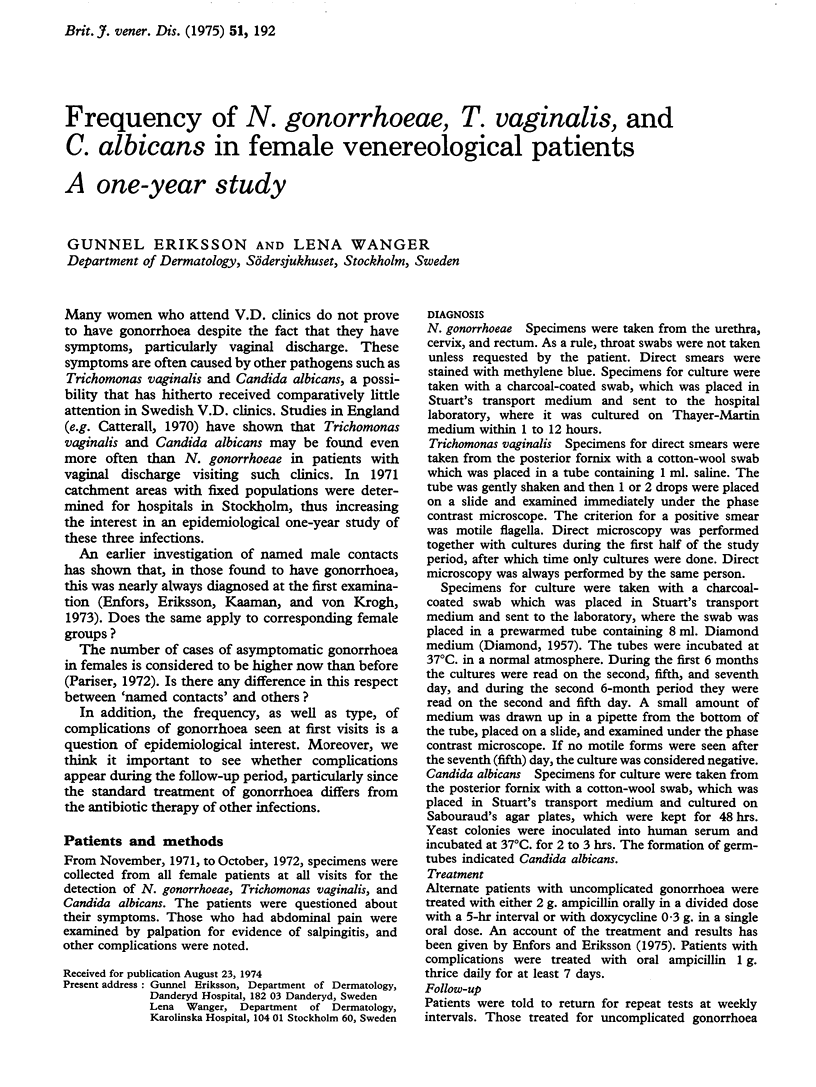
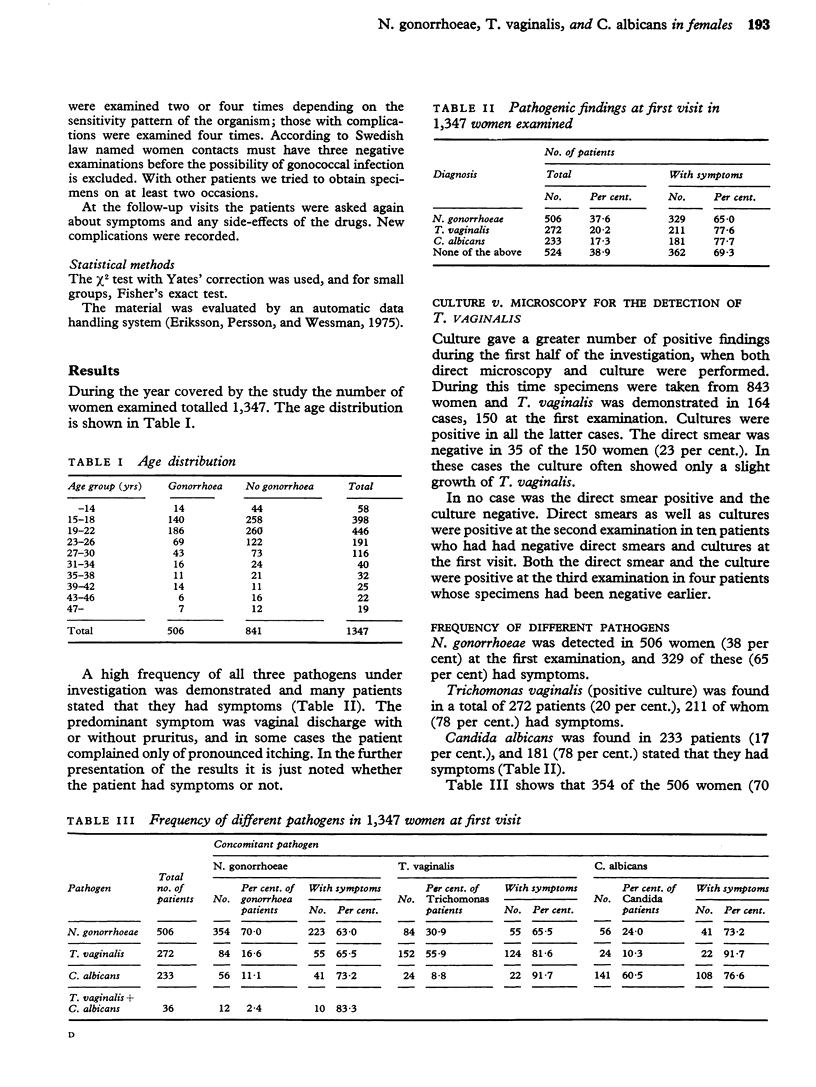
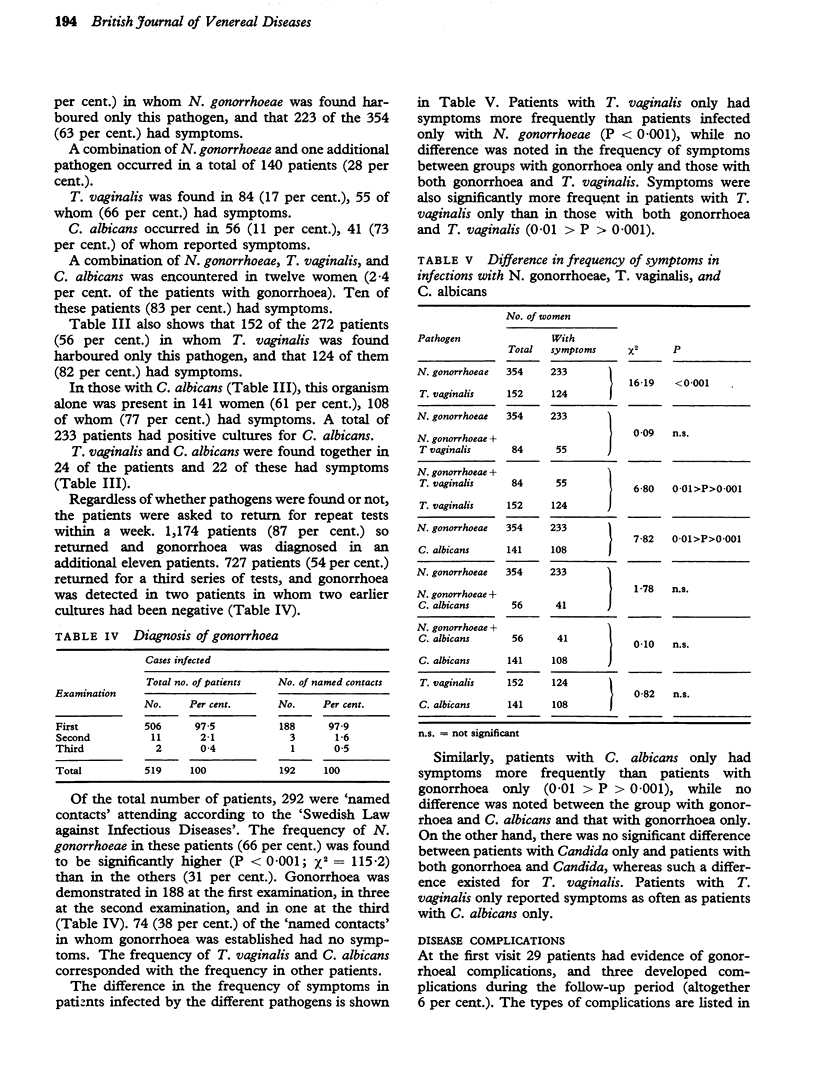
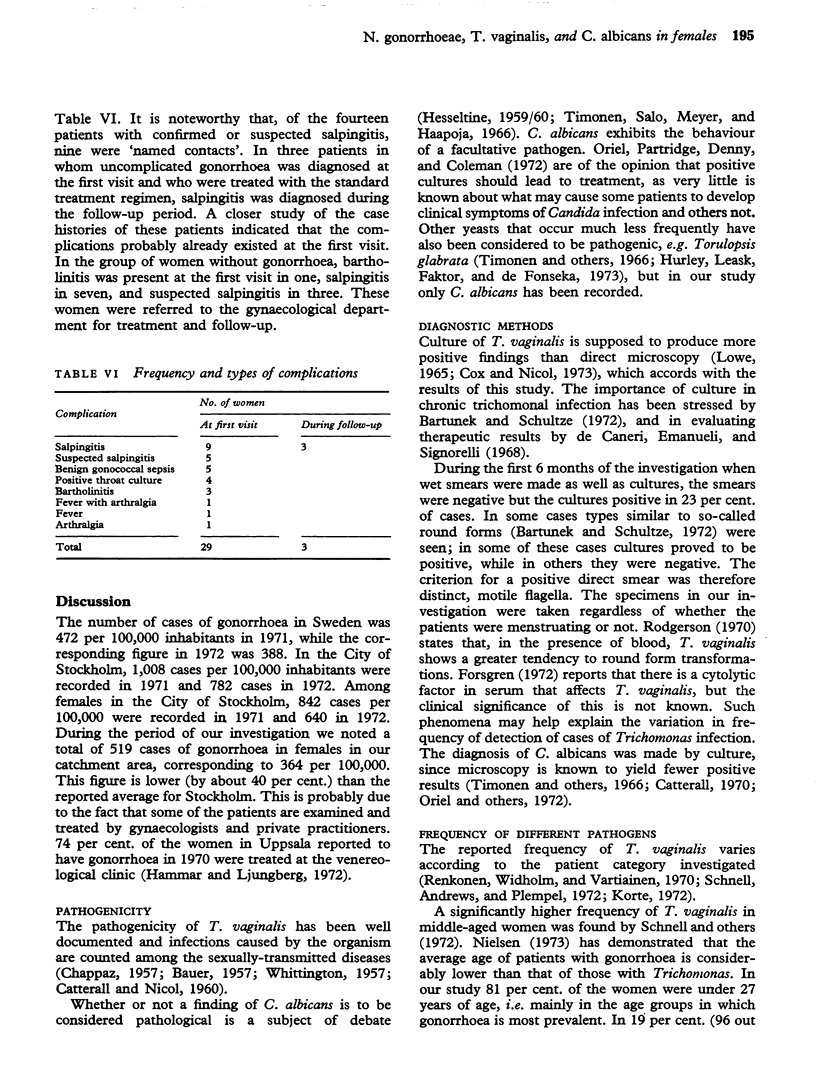
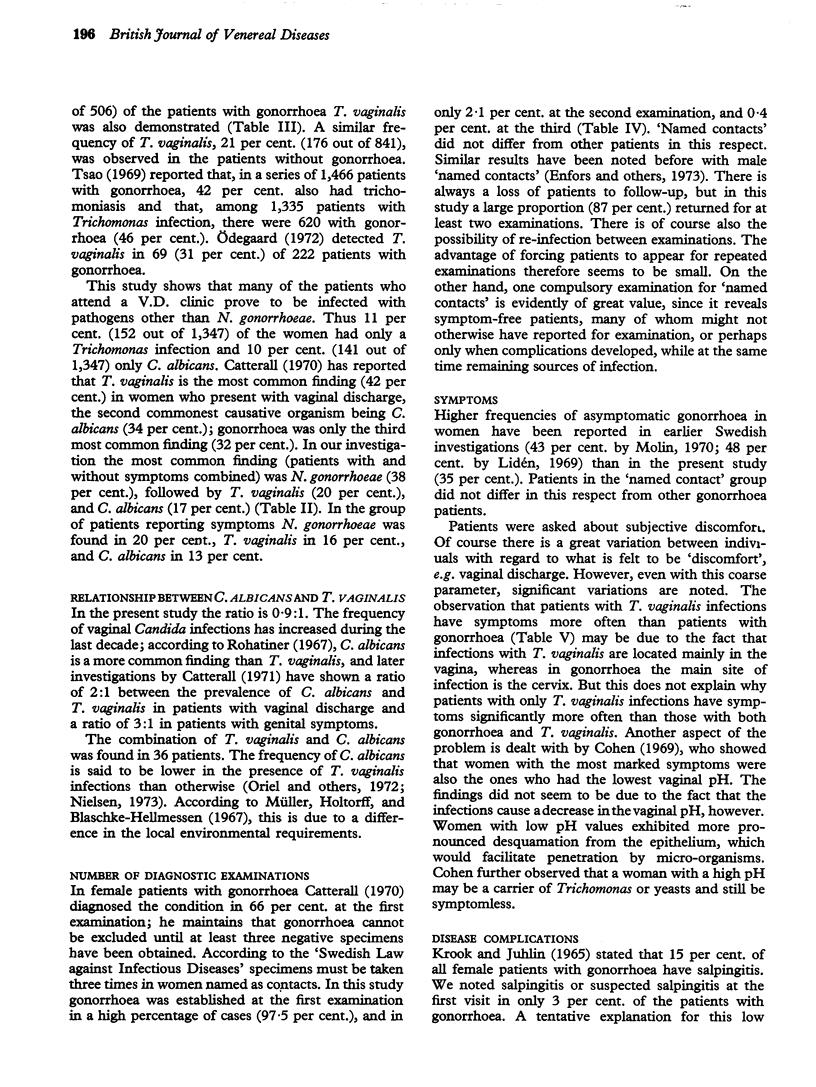
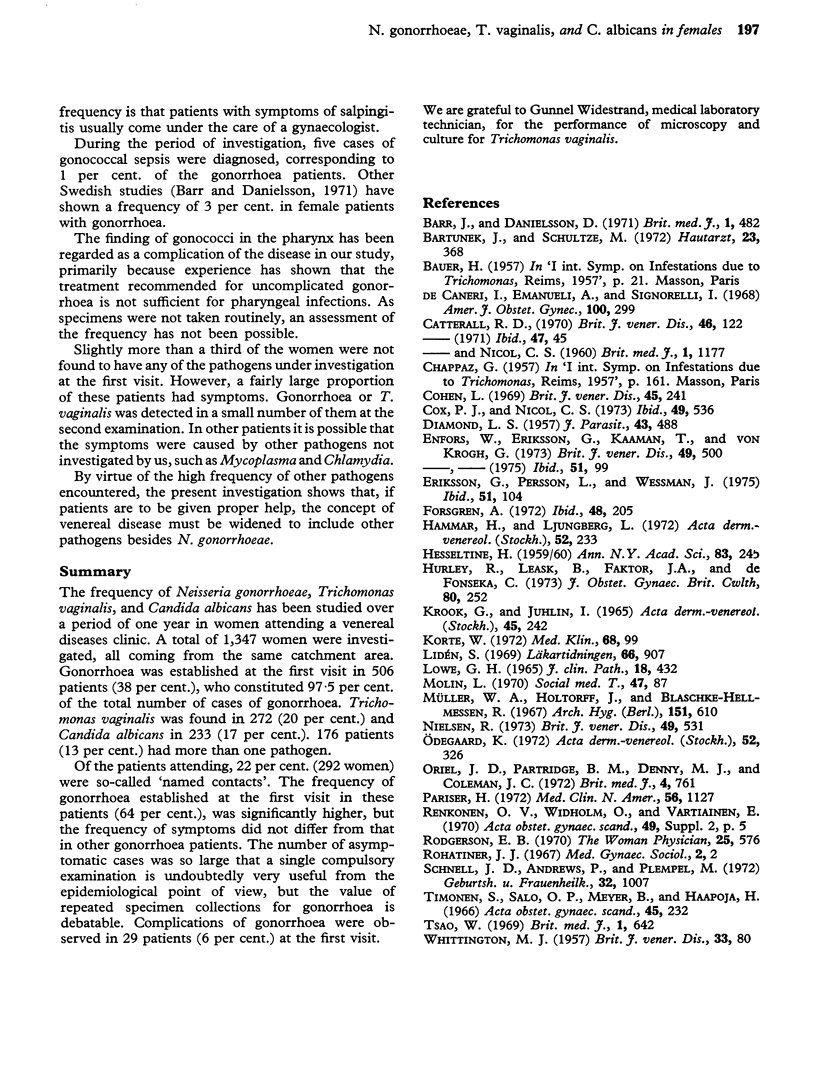
Selected References
These references are in PubMed. This may not be the complete list of references from this article.
- Barr J., Danielsson D. Septic gonococcal dermatitis. Br Med J. 1971 Feb 27;1(5747):482–485. doi: 10.1136/bmj.1.5747.482. [DOI] [PMC free article] [PubMed] [Google Scholar]
- Bartunek J., Schultze M. Trichomoniasis vaginalis. Methodik der Diagnostik und Untersuchungsergebnisse. Hautarzt. 1972 Aug;23(8):368–370. [PubMed] [Google Scholar]
- Catterall R. D. Influence of gestogenic contraceptive pills on vaginal candidosis. Br J Vener Dis. 1971 Feb;47(1):45–47. doi: 10.1136/sti.47.1.45. [DOI] [PMC free article] [PubMed] [Google Scholar]
- Cohen L. Influence of pH on vaginal discharges. Br J Vener Dis. 1969 Sep;45(3):241–247. doi: 10.1136/sti.45.3.241. [DOI] [PMC free article] [PubMed] [Google Scholar]
- Cox P. J., Nicol C. S. Growth studies of various strains of T. vaginalis and possible improvements in the laboratory diagnosis of trichomoniasis. Br J Vener Dis. 1973 Dec;49(6):536–539. doi: 10.1136/sti.49.6.536. [DOI] [PMC free article] [PubMed] [Google Scholar]
- DIAMOND L. S. The establishment of various trichomonads of animals and man in axenic cultures. J Parasitol. 1957 Aug;43(4):488–490. [PubMed] [Google Scholar]
- Enfors W., Eriksson G., Kaaman T., von Krogh G. Neisseria gonorrhoeae identified by the direct fluorescent antibody technique in male contacts. Br J Vener Dis. 1973 Dec;49(6):500–504. doi: 10.1136/sti.49.6.500. [DOI] [PMC free article] [PubMed] [Google Scholar]
- Eriksson G., Persson L., Wessman J. Clinical applications of an automatic data handling system for sexually-transmitted diseases. Br J Vener Dis. 1975 Apr;51(2):104–109. doi: 10.1136/sti.51.2.104. [DOI] [PMC free article] [PubMed] [Google Scholar]
- Forsgren A. Influence of normal human serum on the determination of trichomonicidal drug concentrations. Br J Vener Dis. 1972 Jun;48(3):205–206. doi: 10.1136/sti.48.3.205. [DOI] [PMC free article] [PubMed] [Google Scholar]
- HESSELTINE H. C. Factors relating to mycotic and trichomonal infections. Ann N Y Acad Sci. 1959 Nov 18;83:245–252. doi: 10.1111/j.1749-6632.1960.tb40897.x. [DOI] [PubMed] [Google Scholar]
- Hammar H., Ljungberg L. Factors affecting contact tracing of gonorrhoea. Acta Derm Venereol. 1972;52(3):233–240. [PubMed] [Google Scholar]
- Hurley R., Leask B. G., Faktor J. A., De Fonseka C. I. Incidence and distribution of yeast species and of Trichomonas vaginalis in the vagina of pregnant women. J Obstet Gynaecol Br Commonw. 1973 Mar;80(3):252–257. doi: 10.1111/j.1471-0528.1973.tb02194.x. [DOI] [PubMed] [Google Scholar]
- Korte W. Epidemiologie, Pathologie und Klinik der Infektion mit Trichomonas vaginalis. Med Klin. 1973 Jan 26;68(4):99–106. [PubMed] [Google Scholar]
- Krook G., Juhlin I. Problems in diagnosis, treatment and control of gonorrheal infections. IV. The correlation between the dose of penicillin, concentration in blood, IC-50-values of gonococci and results of treatment. Acta Derm Venereol. 1965;45(3):242–253. [PubMed] [Google Scholar]
- LOWE G. H. A COMPARISON OF CURRENT LABORATORY METHODS AND A NEW SEMI-SOLID CULTURE MEDIUM FOR THE DETECTION OF TRICHOMONAS VAGINALIS. J Clin Pathol. 1965 Jul;18:432–434. doi: 10.1136/jcp.18.4.432. [DOI] [PMC free article] [PubMed] [Google Scholar]
- Nielsen R. Trichomonas vaginalis. II. Laboratory investigations in trichomoniasis. Br J Vener Dis. 1973 Dec;49(6):531–535. doi: 10.1136/sti.49.6.531. [DOI] [PMC free article] [PubMed] [Google Scholar]
- Oriel J. D., Partridge B. M., Denny M. J., Coleman J. C. Genital yeast infections. Br Med J. 1972 Dec 30;4(5843):761–764. doi: 10.1136/bmj.4.5843.761. [DOI] [PMC free article] [PubMed] [Google Scholar]
- Pariser H. Asymptomatic gonorrhea. Med Clin North Am. 1972 Sep;56(5):1127–1132. doi: 10.1016/s0025-7125(16)32338-0. [DOI] [PubMed] [Google Scholar]
- Schnell J. D., Andrews P., Plempel M. Die vaginale Kontamination der weiblichen Bevölkerung einer Grossstadt mit Trichomonaden und Hefen. Geburtshilfe Frauenheilkd. 1972 Dec;32(12):1007–1014. [PubMed] [Google Scholar]
- Timonen S., Salo O. P., Meyer B., Haapoja H. Vaginal mycosis. Acta Obstet Gynecol Scand. 1966;45(2):232–247. doi: 10.3109/00016346609158448. [DOI] [PubMed] [Google Scholar]
- Tsao W. Trichomoniasis and gonorrhoea. Br Med J. 1969 Mar 8;1(5644):642–643. doi: 10.1136/bmj.1.5644.642-d. [DOI] [PMC free article] [PubMed] [Google Scholar]


